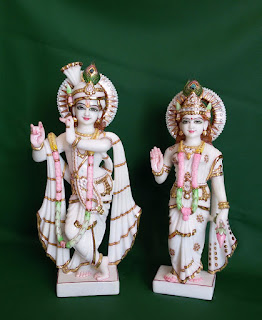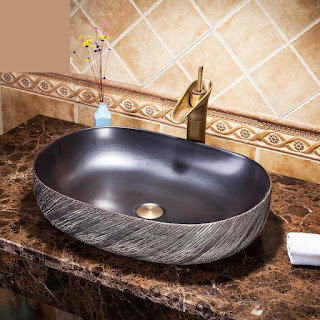History of Indian Sculpture:
The tradition of Indian sculpture is the oldest in the world, dating back to the Indus Valley civilization in which people made statues and figures of bronze and stone. Ever since then, Indian sculpture has refined and expanded in scope and established itself as one of the finest in the world. The sculptures in the Ellora caves are India's pride, as are the intricate sculptures that adorn India's temples. One has only to glance at the sculptures that adorn the temples of Khajuraho to recognize the talent of India's sculptors.
The ancient tradition of sculpting is still preserved in all its glory, and at the same time, artisans have innovated and introduced new forms of sculpting, working with diverse materials and exploring myriad themes.
Themes of Indian Sculpture:
Indian craftsmen have always been fascinated by figures from mythology and religion. Sculptures of Hindu gods and goddesses, of other Hindu figures, of Buddha , and figures from Christianity and other religions have hence dominated their work. In addition, they have also carved beautiful statues and sculptures inspired by everyday life, as well as court life. India boasts of sculptures of animals, birds, and human figures. Indian artists also experiment with abstract sculpture and sculpture in other media.
Materials used for Sculpture:
In India, sculptures have been made of all kinds of raw material. While some of them have been created out of a single solid chunk of the material, others have been crafted in parts, and then joined together. Some of the materials used by artisans are:
Wood (link to article: Wood Sculptures ) (teak, rosewood, sandalwood, kikar, sal, walnut, mango, dhudi, among others)
Stone ( marble (link to article: Marble Sculptures ), jade, sandstone, soapstone, hydrostone, granite and others)
Bronze (link to article: Bronze Sculptures)
Brass
Papier mache
Fiber glass
Ceramic
Clay
Plaster
Ivory
Horn
Pewter
Gold
Silver
Terracotta
Ice
Sand
Glass
The tradition of Indian sculpture is the oldest in the world, dating back to the Indus Valley civilization in which people made statues and figures of bronze and stone. Ever since then, Indian sculpture has refined and expanded in scope and established itself as one of the finest in the world. The sculptures in the Ellora caves are India's pride, as are the intricate sculptures that adorn India's temples. One has only to glance at the sculptures that adorn the temples of Khajuraho to recognize the talent of India's sculptors.
The ancient tradition of sculpting is still preserved in all its glory, and at the same time, artisans have innovated and introduced new forms of sculpting, working with diverse materials and exploring myriad themes.
Themes of Indian Sculpture:
Indian craftsmen have always been fascinated by figures from mythology and religion. Sculptures of Hindu gods and goddesses, of other Hindu figures, of Buddha , and figures from Christianity and other religions have hence dominated their work. In addition, they have also carved beautiful statues and sculptures inspired by everyday life, as well as court life. India boasts of sculptures of animals, birds, and human figures. Indian artists also experiment with abstract sculpture and sculpture in other media.
Materials used for Sculpture:
In India, sculptures have been made of all kinds of raw material. While some of them have been created out of a single solid chunk of the material, others have been crafted in parts, and then joined together. Some of the materials used by artisans are:
Wood (link to article: Wood Sculptures ) (teak, rosewood, sandalwood, kikar, sal, walnut, mango, dhudi, among others)
Stone ( marble (link to article: Marble Sculptures ), jade, sandstone, soapstone, hydrostone, granite and others)
Bronze (link to article: Bronze Sculptures)
Brass
Papier mache
Fiber glass
Ceramic
Clay
Plaster
Ivory
Horn
Pewter
Gold
Silver
Terracotta
Ice
Sand
Glass
Marble has been one of the most popular choices of material for crafting statues since ancient times. Marble sculptures are not only sturdy and durable; they are elegant and sophisticated as well.
Marble is naturally occurring limestone. In India, marble has been quarried in various places. Marble deposits are most widespread in Rajasthan and Gujarat. They are also found in Andhra Pradesh, Madhya Pradesh, Jammu and Kashmir, Haryana and Maharashtra. Marble is sometimes stained. It is commonly held that the best quality marble has no or very few stains. A skilled artisan learns to incorporate naturally present stains in his marble sculptures.
In India, marble craftsmen do not restrict themselves to pure white marble. They make beautiful statues of green marble, red marble, black marble as well as gray marble.
Though it is perhaps true to a certain extent that marble statues in India are not as widely popular as those made of bronze and brass , wood and stones like soapstone, granite and sandstone, it is also true that when and where they are sculpted, they are a delight to behold. The most popular marble sculptures in India are those of Hindu gods and goddesses . These Hindu statues are placed in temples, as well as in religious shrines at home. They are also popular as decorative items. Statues of mythological figures and saints are also crafted in marble. Marble is also used to sculpt Buddhist statues and Christian figures.
Among the sculpture collection composed of Makrana marble found at PRIMITIVE are statues of deities from the Hindu pantheon, religious and spiritual leaders, decorative furniture, functional objects and architecture. Despite Makrana marble being a solid, dense material, the sculptures exhibit what can be called a refined softness, grace, fluidity and remarkably life-like features. They all attest to the exceptional skill of the artists who created them.
Makrana, located in Rajasthan, is considered one of the oldest and finest marble quarries in India. Marble is called metamorphic rock. Formed from limestone under conditions of high temperature and extreme pressure, it is the concentration of calcium carbonate in the limestone and presence of mineral impurities that determine the quality and whiteness of marble. The purest marble, such as what’s mined at Makrana, consist of over 99% calcite crystals, giving them their remarkable unblemished white hue.











Comments
Post a Comment